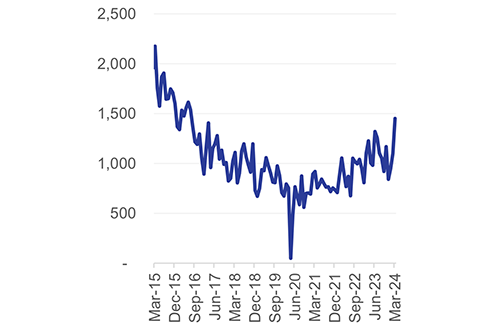Edgar Brandt
New vehicle sales in Namibia during May 2022 slowed considerably to below its six-month moving average after experiencing a sales spike during April. Economists consider vehicle sales an excellent barometer of economic activity and available household spending as car purchases are easily postponed when households and businesses are cash strapped. It is also known that a country’s Gross Domestic Product has a positive correlation with vehicle sales, as in the higher the GDP, the higher the car sales.
The latest figures show new vehicle sales in Namibia of 767 units in May 2022, compared to 905 during April, which is a decrease of 15.2% month-on-month (m/m). This is also 2.9% fewer year-on-year (y/y) than the 790 vehicles sold in May 2021 according to the National Association of Automobile Manufacturers of South Africa (NAAMSA), which also compiles Namibian sales figures.
“Taking the above global developments into account, we believe that local dealerships selling German brands might be able to source vehicle imports more easily compared to other brands. However, given the small size of the Namibian auto market in the global context, it could also be that improved car production levels are sold off to bigger markets globally to address major backlogs. This will likely keep vehicle price inflation elevated in Namibia and limit vehicle sales as supply remains artificially constrained,” stated Theo Klein, an economist at local stock brokerage, Simonis Storm Securities (SSS).
The NAAMSA figures also show that passenger and light commercial vehicles continue to be the bulk of new vehicle sales, accounting for 52.4% and 40.3% of total sales respectively in May 2022. On an annual basis, passenger vehicle sales increased by 12.3% y/y, light commercial decreased 16.7% y/y, medium commercial decreased 40% y/y, heavy commercial was down 33.3% y/y and extra-heavy commercial increased marginally at 3.0% y/y in May 2022.
These NAAMSA figures indicate that new vehicle sales averaged 863 units per month for the year-to-date, which is above the monthly averages of 810 and 550 recorded in the same period during 2021 and 2020 respectively. The year-to-date (YTD) monthly average is very close to the pre-pandemic monthly average of 869 recorded in 2019.
Meanwhile, Klein pointed out that Namibia’s peak tourist season is approaching and as indicated in SSS previous reports, numerous establishments allude to bookings being full in the upcoming months.
Said Klein: “Local rental companies had a fleet of about 8 500 vehicles prior to the pandemic outbreak and currently have about 2 000. Sourcing new vehicles in order to rebuild their fleet in response to rising self-drive demand has proven challenging due to shortages in stock in recent weeks.”
He added that rental companies typically increase the size of their fleet during the peak tourist season, between May and July, but the latest data shows an exception to this trend.
“We believe that vehicle sales to rental companies might undershoot previous peak tourist seasons as a result of ongoing supply constraints,” said Klein.
Meanwhile, the SSS report shows that instalment and leasing credit growth has grown sluggishly amongst households, averaging growth of 1.2% YTD and 0.9% in the last 12-months. This, Klein stated, is indicative of a number of local dealerships who point out there are numerous declines in vehicle loans amongst their clients from local banks.
“As a result, the proportion of cash sales have increased compared to credit sales. On the other hand, instalment and leasing credit amongst corporates has increased by double digits in March and April 2022 and averages monthly growth of 9.2% YTD and 1.4% in the last 12-month,” Klein stated.
The SSS report continued about signs of the global shortage in semiconductors (electronic chips) easing, albeit short lived as expected by the market. As a result, global vehicle manufacturers such as Mercedes Benz AG, Daimler Truck Holding AG and BMW AG are now receiving sufficient high-tech components to produce at full capacity following critical shortages in the last two years.
Moreover, Klein pointed out that global passenger car production remains far below pre-pandemic levels while some auto manufacturers are concerned about future consumer demand amidst rising inflation and interest rates. But, German carmakers are confident they can pass on rising raw material costs onto consumer prices according to an Ifo Institute for Economic Research survey.
However, a new shortage has been looming globally in wire harnesses which are a cheap component that bundles cables together. Klein noted that Ukraine is a significant provider of this low tech, low margin component which is made from wire, plastic and rubber using low-cost manual labour. “While wire harnesses do not receive as much media attention such as chips, cars cannot be built without them,” Klein cautioned.
Other auto firms have shifted harness production away from Ukraine to other low-cost countries.
“If Namibia had favourable ease of doing business scores, and a pro-business environment for foreign auto firms, this could have been an opportunity for the country to produce the required wire harnesses which in turn could have made use of abundant unskilled labour in Namibia. Mercedes Benz AG was able to source harnesses from Mexico, Japanese suppliers added capacity in Morocco and others have sought new production lines in Tunisia, Poland, Serbia and Romania,” Klein stated.


